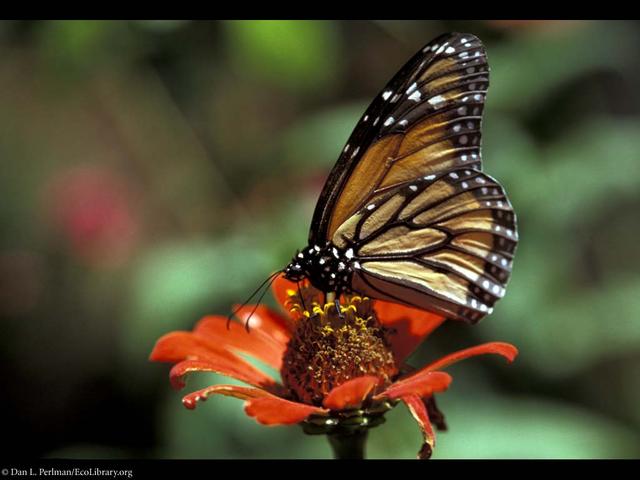Click image to advance. | ||||||||||||||||||||||||||||

| ||||||||||||||||||||||||||||
| © Copyright Dan L. Perlman, 2005-2007 | ||||||||||||||||||||||||||||
| Aposematic coloration in Monarch butterfly, Costa Rica. Monarch butterflies are distasteful and toxic. When they are caterpillars, they feed on milkweed plants, which contain a host of toxins and are largely immune to attack from other insect herbivores. The caterpillars sequester the toxins within parts of their bodies, where they cause no harm, and these toxins stay in the animals when they become adult monarchs. The adults are strikingly colored, and after a bird has tried to eat one it will typically spit the butterfly out and will avoid them thereafter. This type of bright and memorable color pattern is called aposematic coloring, and acts as a warning. Monarchs are also famous for their annual migrations; late in the summer, all monarchs from the eastern two-thirds of the USA and Canada migrate south to overwinter in a small area of pine forests high in the mountains of Mexico. When spring arrives, the individuals that have survived begin a flight northward. Once they reach the southern USA, they stop to lay eggs and there they die. Their offspring and grandoffspring head north as the summer progresses. Although it was once thought that Viceroy butterflies, which look very similar to Monarchs, were palatable, now scientists believe that both species are unpalatable to predators, making them a classic example of Mullerian mimicry.
| ||||||||||||||||||||||||||||
| Set image width: 640 · 720 · 800 · 1000 · 1200 · 1500 · max pixels. • Click image to advance. | ||||||||||||||||||||||||||||
Click here to send feedback about this page to info@ecolibrary.org Discover Life | Education | EcoLibrary | Advance | Top Updated: 2024-11-01 00:34:06 gmt © Designed by The Polistes Corporation | ||||||||||||||||||||||||||||